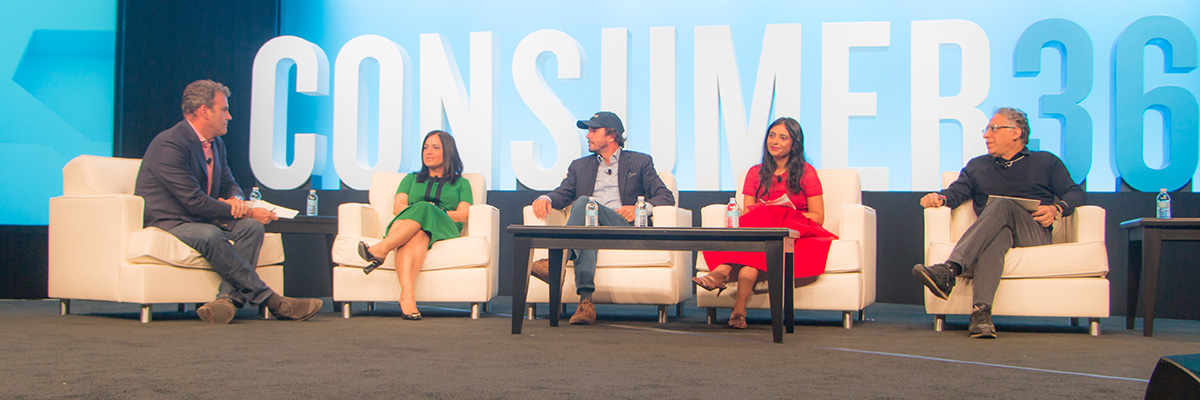There’s arguably never been a better time to consume content. Yet while today’s media landscape is a boon from a choice perspective, the glut of content, messaging and perspectives presents myriad challenges for media companies, publishers and brands—all of whom have the exact same goal regardless of their individual business: reach consumers and build loyalty with them.
So in an era where brands need to move beyond simply knowing if consumers have the television on to whether consumers are actually engaged with what’s on the screen, companies are weighing an array of strategies in effort to break through, captivate and establish long-term relationships with consumers.
Big data, direct-to-consumer initiatives, cause marketing, and cross-brand partnerships are all in the mix, and it’s creating what James Cooper, editorial director at Adweek, says is the most interesting times in media he can remember. And we learned James isn’t alone, as he led a panel of industry leaders during a discussion about building loyalty at this week’s Consumer 360 event in Washington, D.C.
As James discussed a resurgence in creative thinking and brand storytelling, he acknowledged that brands are trying new things, largely as a result of a consumer evolution. With that as a backdrop, he asked his panelists to weigh in on the role of data, brand storytelling, successful engagement strategies and efforts that will be successful going forward as the stakes for engagement get even higher.
“It’s no longer about reward points,” began Kavita Vazirani, EVP, Strategic Insights & Analytics at NBCUniversal. “Brands are making connections with other brands. They’re partnering with influencers. And it’s all being done to create a stronger proposition. We all want something that will be relevant for us so we can interact with brands differently.”
So how are brands developing the strategies that are driving these interactions? While the panelists agreed that data plays a role, they stressed that it’s not a silver bullet—and it typically isn’t very effective when leveraged in a vacuum.

“It’s reckless to ignore data, but it’s lame to rely solely on the data,” said Peter McGuinness, CMO, Chobani. “Anyone can look at spreadsheets and say ‘yes’ or ‘no’. So when I look for data, I talk to our sales teams.”“I really try to focus on finding ways to unify the whole process,” added Kavita. “Silos are just for reporting structures. Let’s focus on the customer—working together. I like to find ways to form unified strategies that rely on partnership across teams.”This type of partnership across teams, however, isn’t too prevalent yet, especially in the consumer product space, added Ravi Dhar, a professor of management and marketing at the Yale School of Management.“I haven’t seen many CPG companies using data creatively,” Ravi said. “I find that the people who use data are doing so in a rather tactical way. I also think the industry needs more of a top-down view, where the C-suite keeps the data teams informed on the larger strategies. That will help create a framework for better data uses.”Radha Subramanyam, EVP, Chief Research and Analytics Officer at CBS Television Network, agreed that she often sees a disconnect between teams.“I’ve never had a PhD deliver data that has transformed a business,” she said. “But when you embed the data teams with others and combine their efforts with those of other disciplines—then you’re on to something.”And that’s something that Peter said his team has already started to do. In fact, he explained that Chobani was able to bring seven different disciplines into one area with the intent to derive insights from the sum of the parts rather than from the individual parts on their own.Getting back to the consumer, each of the panelists stressed that brands can’t try to control the customer journey. Rather, they need to understand it and find ways to join them along the way in meaningful ways. At Chobani, for example, Peter talked about building a company that people like—even if they don’t like yogurt. At NBCUniversal, Kavita talked about Prime Pods, which are 60-second ad spots used during prime time instead of lengthier ad breaks. “There’s clutter out there, and we’re all trying to capture share of mind,” Kavita said. “So we’ve tried to create an environment where consumers can experience content in a much less cluttered environment. And we’ve found that, as a result, they stay engaged with the content, the brand and the advertiser. Our responsibility is to keep the consumer engaged.”On the subject of media engagement when fragmentation is growing, Ravi noted the difference between having a device on and being truly engaged with it.“If you look at TV, people aren’t watching significantly less,” he said. “But device usage is going up. So when we’re multi-tasking, what are they paying attention to? That’s where the dollars need to focus.”“Indeed, the share of time on platform doesn’t speak to the impact of the platform,” added Kavita. “So as we look at channel mixes and devices, it’s important to be careful about share of time metrics with respect to the effectiveness of the platform.”From a brand view, Peter stressed the need to take a stance and stay on course. In fact, he noted that Chobani is so committed to its mission that it never takes anything off its social media channels—no matter how bad it might be.“We try to do the right thing even if it’s not popular,” he said. “We never use social to cheapen the mission or value. We don’t want to exploit it. It wouldn’t be authentic. We stand for what we stand for because we believe in it and we have resisted commercializing it.”Despite the clutter, fragmentation, broadening demographics and plethora of channels that consumers have access to, Kavita perhaps said it best when she posed a very simple perspective: “Follow the consumer. The consumer will lead you to where you need to be. Have a strong point of view about the products you make and don’t waiver. Consumers want brands to be relevant for them. That’s what consumers want. If you just make a product and talk about the product, you’ll likely become irrelevant.”



